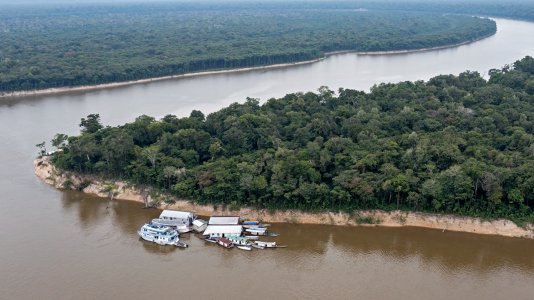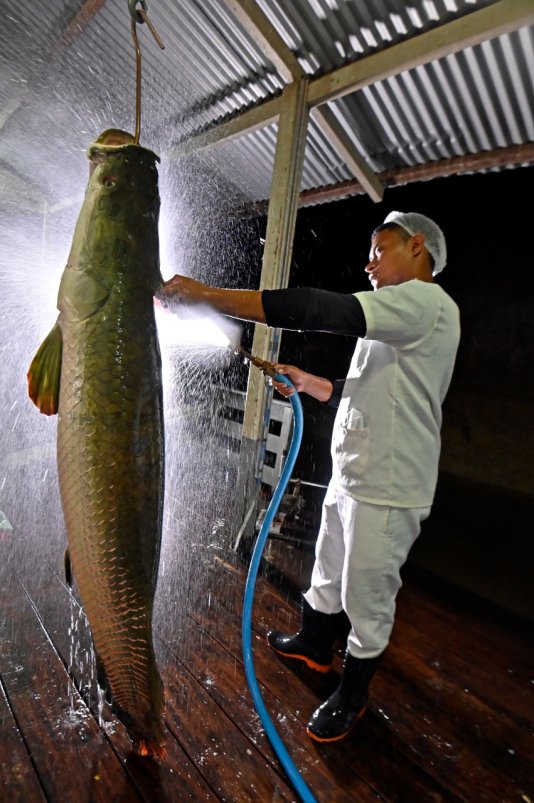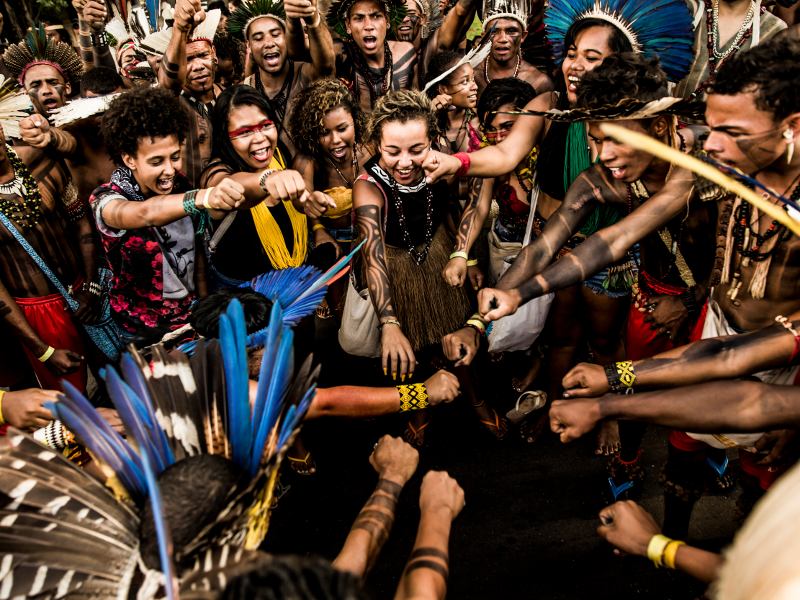- About
- Topics
- Picks
- Audio
- Story
- In-Depth
- Opinion
- News
- Donate
-
Signup for our newsletterOur Editors' Best Picks.Send
Read, Debate: Engage.
| December 19, 2022 | |
|---|---|
| topic: | Conservation |
| tags: | #sustainable fishing, #indigenous people, #indigenous knowledge, #Amazon |
| located: | Brazil |
| by: | Marina Rabello |
"There were children that had never seen a pirarucu," recalls Maria do Rosário Paumari, referring to a not-so-distant past. Back then, the three indigenous lands of her indigenous people on the Tapauá River in the south of Amazonas in the Brazilian Amazon were constantly invaded by large scale fishing boats that were making pirarucu and other species of fish and turtles scarce.
This reality began to change when the indigenous people discovered the sustainable and communal management of pirarucu. Over ten years of sustainable fishing, celebrated in 2022, the communities generated a gross revenue of almost USD 300,000,00, which recovered the pirarucu population and strengthened territory surveillance. It also continues to guarantee food security and helps to conserve thousands of hectares of forest in the Amazon.
As the world's largest fish with freshwater scales, the pirarucu (Arapaima gigas) can reach two hundred kilos and three metres in length. Its meat is highly appreciated in the northern states of Brazil and has therefore come close to extinction.
In 1996, the Brazilian Institute for the Environment and Renewable Natural Resources (Ibama) banned pirarucu fishing in the state of Amazonas, allowing the capture of this fish only within the scope of sustainable pirarucu management initiatives.
Today, these initiatives are responsible for the recovery of pirarucu and other fish species in protected areas in the state. The Paumari were one of the precursors to implementing sustainable management of pirarucu in indigenous lands. Since 2009, they have intensified surveillance of lakes and began to monitor arapaima stocks annually.
It took five years of fishing restrictions in the territory for the pirarucu population to begin to recover. Only in 2013 was the first sustainable fishing carried out.
Now, Ibama allows communities that develop sustainable management to fish an annual quota of up to 30 percent of the adult arapaima counted. Only individuals over 1.5 metres can be captured and marketed; the size indicates that the fish is already in the adult phase and that it has already been able to reproduce. Fishing for juvenile pirarucus is prohibited because at this stage the fish are not yet mature for reproduction.
Through the protection of lakes and regulation of fishing, the Paumari increased the population of pirarucu in their territory by more than 600 percent since the first count in 2009.
"Yesterday we saw pirarucus floating in the Tapauá river, which had not happened for a long time," celebrated Sara Paumari, pioneer leader of the management. "This means that the lakes are full because the fish are leaving the lakes for the riverbed."
One of the first steps towards implementing a sustainable management initiative is to strengthen the collective organisation of communities to take care of the biodiversity in their territories - either through surveillance, which prevents invaders and predatory activities, or through the construction of collective agreements for sustainable use of resources.
"Predatory fishing was causing a shortage of fish, which are essential for subsistence and the Paumari culture," said Gustavo Silveira, the technical coordinator of the Native Amazon Operation (OPAN) which, through the Roots of Purus project sponsored by Petrobras, has been supporting the Paumari since 2013.
"We presented an alternative that would guarantee the quality of life of future generations, and the people worked together to open this new path," he added. "Today, management helps conserve biodiversity in indigenous lands, and is a source of sustainable income."
Currently, the Paumari have seven floating bases positioned at strategic points in the territories where invasions tend to take place.
"When the rivers start to dry up, we position the bases and watch the entrances to lakes and creeks twenty-four hours a day," explained Francisco Paumari, coordinator of the sustainable management of pirarucu. "Apart from this more intense period of surveillance, we make four rounds throughout the vulnerable points of the indigenous lands at different times of the year."
The surveillance system has been effective in inhibiting invasions, but this continues to be a problem faced daily by communities.
"They keep an eye on our routine, and when we go to meetings they take the opportunity to invade to catch chelonians and arapaimas. For this reason, even during fishing, the teams need to be on duty," said Margarida Paumari from the council of leaders of the People from Water Indigenous Association (AIPA). The organisation represents the communities of the three indigenous lands on the Tapauá River and is the product of the collective organisation promoted by the sustainable management.
In this context, point out the Paumari, it is essential to have the support of the bodies responsible for inspecting protected areas, which can effectively expel invaders.
"We ask the invaders to leave, we explain that they cannot fish in our territory," said Maria do Rosário. "But some ignore it and get upset. We must have the support of the authorities."
When it comes to sustainable management of pirarucu, it isn't just the fish itself, known as the Amazonian giant, which stands out. During the fishing period, which lasts an average of three weeks, communities are divided into teams that work twenty-four hours a day catching, transporting and treating the fish. They carry out other tasks as well, such as preparing meals and washing uniforms. 46 tons of ice are needed to refrigerate the arapaima between fishing and its arrival in the city of Manacapuru, where the fish is processed and packed.
This route is done by boat and takes four days on average. In 2012, 448 adult pirarucus were counted, and the quota authorised by Ibama was 50 individuals, totaling three tons of fish.
In 2021, 2995 adult pirarucus were counted, resulting in a quota of 650 individuals and more than 36 tons of high-quality animal protein sold through AIPA to the Association of Rural Producers of Carauari (ASPROC). ASPROC coordinates a fair and collective commercial arrangement of sustainably-sourced pirarucu that brings together indigenous and riverine community-based associations that carry out management in their territories. The group created a collective brand called Gosto da Amazônia through which to sell pirarucu in São Paulo, Rio de Janeiro, Belo Horizonte, Brasília and Recife.
Collectively, the Paumari decided that 30 percent of the income generated by selling the fish would be allocated to AIPA. With the support of Roots of Purus and other projects carried out by OPAN, the Paumari have been progressively and continuously training themselves on how to manage their association and carry out processes related to management and fishing. They have also made notable advances in developing the mechanisms at their disposal, in particular the acquisition of floats for surveillance and the pre-processing of pirarucu. The latter involves stainless steel tables, a winch to lift and move the fish and hoses with treated water used to clean the arapaima.
It seems that the sustainable management of pirarucu inspires a great sense of pride among the Paumari. "We are very happy with the abundance not only of pirarucu, but of other fish and animals in our territory and with the quality of the structure that we conquered for management," said Nilzo Paumari.
"It is a responsibility of young people to continue our work, because we are guaranteeing the quality of life of current and future generations."
Image by Adriano Gambarini.


By copying the embed code below, you agree to adhere to our republishing guidelines.
